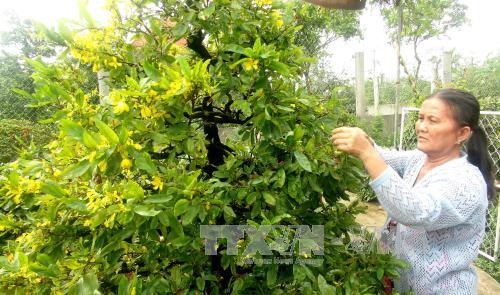 Society
Society

Flower villages in the Cửu Long (Mekong) Delta fear ther supply of flowers and ornamental plants for Tết (Lunar New Year) next month will decline because of unfavorable weather.
 |
| Inclement weather has caused many yellow apricot flowers in Phước Định Village in Vĩnh Long Province’s Long Hồ District, meant for Tết, to blossom too early. — VNA/VNS Lê Thuý Hằng |
HCM CITY — Flower villages in the Cửu Long (Mekong) Delta fear their supply of flowers and ornamental plants for Tết (Lunar New Year) next month will decline because of unfavourable weather.
Prolonged rains late last month and early this month in the delta caused inundation that killed many plants and caused others to blossom early.
Nguyễn Thị Lùn of Long Thới Commune in Bến Tre Province’s Chợ Lách District, one of the largest flower growing areas in the delta, said she planted more than 1,500 pots of daisy three months ago.
“However, prolonged rains inundated them and killed them. To have flowers to sell during Tết, I have had to switch to marigold.”
Nguyễn Văn Thảnh of Chợ Lách District’s Hưng Khánh Trung B Commune said drought and saltwater intrusion earlier this year damaged half of the 3,000 kumquat trees he was growing for Tết.
“I tried to rescue the remaining trees but they are growing too slowly and are not good looking like in previous years.”
Drought and saltwater intrusion destroyed more than 3,000ha of flowers and ornamental trees, seedlings and fruit trees, according to the Chợ Lách District Agriculture and Rural Development Bureau.
Most people in Chợ Lách’s Long Thới, Hưng Khánh Trung B and Vĩnh Thành communes make a living by growing flowers and ornamental trees year round, but Tết is their main business season.
Bùi Thanh Liêm, head of the bureau, said the supply of flowers and ornamental trees for Tết would be down because of the prolonged rains and saltwater intrusion.
District officials have helped farmers reduce the damage caused by inclement weather, he said.
The district expects to see its supply of flowers and ornamental trees during Tết fall by 10 per cent from last year to around 10 million pots, according to the bureau.
The inclement weather has also caused many ochna trees to bloom early.
In Phước Định Village in Vĩnh Long Province’s Long Hồ District, one of the delta’s largest ochna plant producers, 30 per cent of the 4,000 plants meant for Tết bloomed at the end of last month and early this month.
The village’s farmers have picked the early blooming flowers, pruned blooming branches and fertilised the plants, hoping they would bud and bloom again during Tết. But the probability is not high, they said.
The village has about 550 ochna plants aged 50-100 years and 10,800 others aged 20-50 years.
Ochna blossoms are a symbol of Tết in the country’s southern region.
In Đồng Tháp Province’s Sa Đéc City, one of the places in the delta where floriculture has been done for the longest time, farmers have planted more than 100ha of flowers and ornamental trees for Tết.
Besides traditional flowers like daisy and marigold, the city is also famous for growing more than 50 kinds of roses.
Because of the prolonged rains, some daisy varieties have been affected by diseases and are growing too slowly, according to the city Agriculture and Rural Development Bureau.
The supply of flowers and ornamental trees for Tết could decline because of the inclement weather, it said.
Nguyễn Thị Cẩm Vân, who grows flowers in Sa Đéc’s Ward 3, said: “The prices of flowers will increase slightly this Tết because the cost of all inputs has increased since last year.” — VNS




